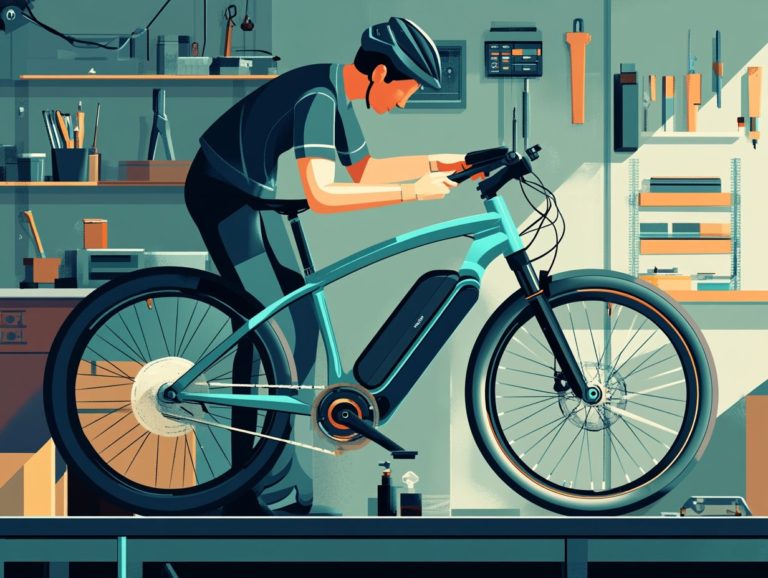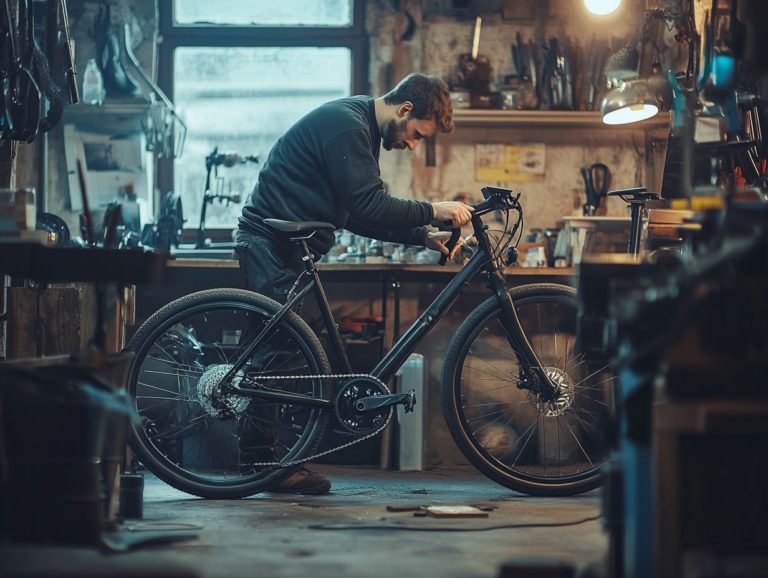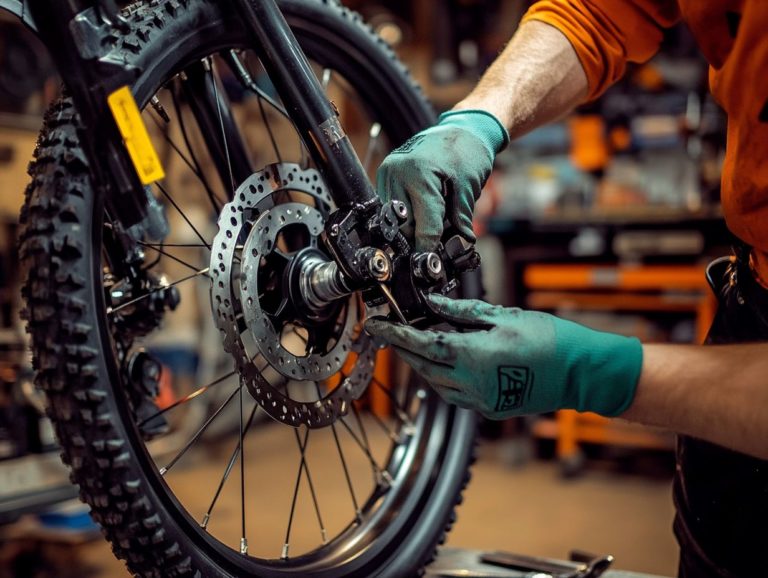How to Perform Electric Bicycle Wire Inspections
Regular inspections of your electric bicycle wires are essential for both safety and performance. Whether you re an experienced cyclist or new to the scene, knowing how to inspect these wires properly can save you from accidents and expensive repairs.
This guide will equip you with the essential tools needed for thorough inspections. It provides a detailed, step-by-step process for examining your bicycle s wiring. You ll also discover common issues you might encounter and receive maintenance tips to keep your electric bicycle in peak condition, ensuring that all components of the bicycle function optimally.
Dive in to equip yourself with essential knowledge that ensures your rides are safe and enjoyable!
Contents
- Key Takeaways:
- Tools Needed for Inspections
- Essential Equipment for Safe and Thorough Inspections
- Step-by-Step Guide to Inspecting Electric Bicycle Wires
- Visual Inspection
- Common Issues Found During Inspections
- Tips for Maintaining Electric Bicycle Wires
- Frequently Asked Questions
- What is an electric bicycle wire inspection?
- Why is it important to perform electric bicycle wire inspections?
- When should I perform an electric bicycle wire inspection?
- What tools do I need to perform an electric bicycle wire inspection?
- How do I perform an electric bicycle wire inspection?
- Can I perform an electric bicycle wire inspection myself or do I need a professional?
Key Takeaways:
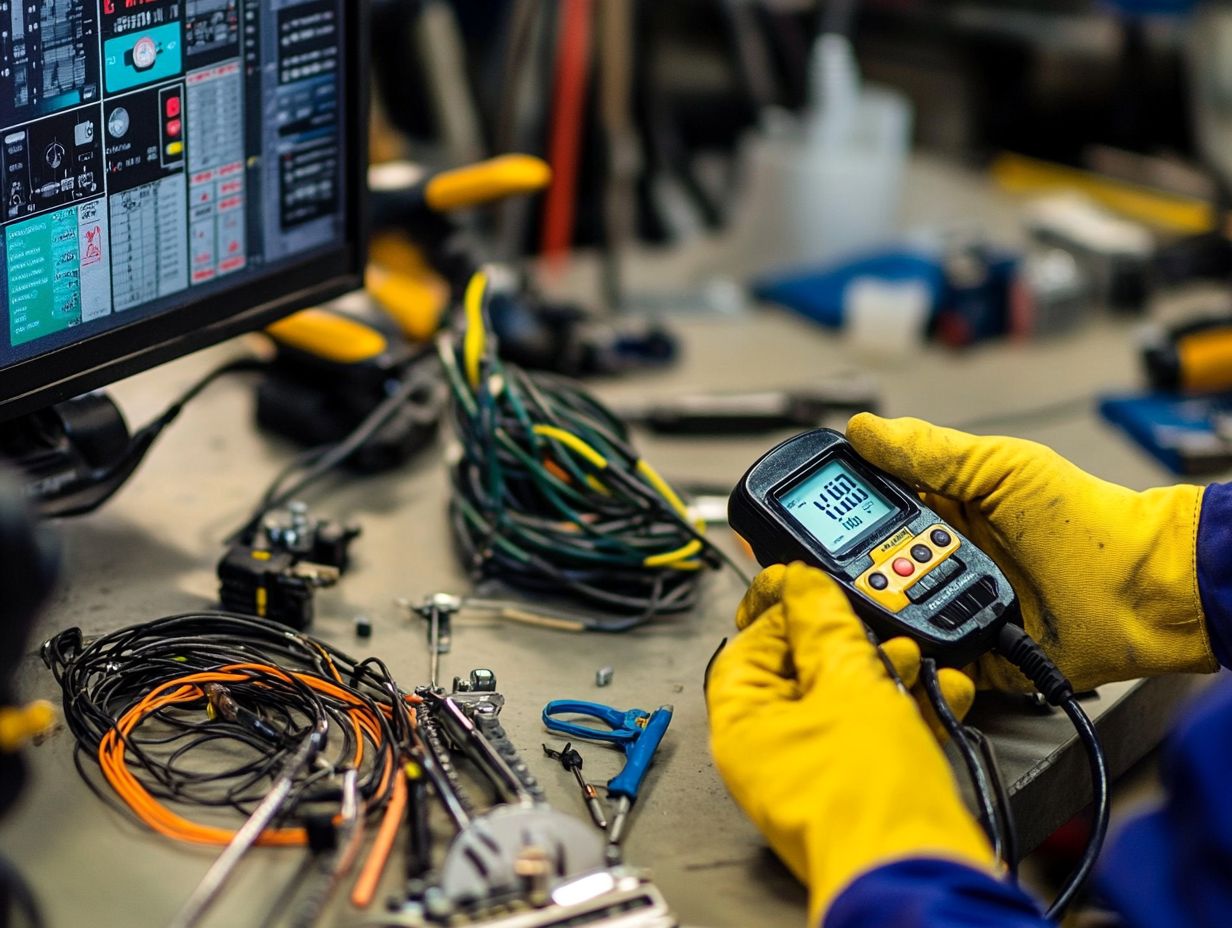
- Regular inspections of electric bicycle wires are crucial for safety and longevity of the bike.
- Essential tools for thorough inspections include a multimeter, wire cutters, and a screwdriver.
- Inspections should include visual checks, continuity testing, and checking for loose connections.
Importance of Regular Inspections
Regular inspections are essential for ensuring the safety and performance of your electric bicycle. These inspections involve a series of important checks that can prevent mechanical failures and enhance your overall riding experience.
The significance of these inspections is particularly pronounced in bustling areas like New York City, where electric bicycle usage is on the rise. To ensure everything runs smoothly, it’s important to know how to prepare for electric bicycle maintenance sessions. Routine evaluations include vital elements such as the brake system and tire pressure.
Electrical testing, including multimeter usage, ensures that every component meets safety standards and mitigates risks associated with riding. Pay close attention to the condition of your tires and brakes, as these components are pivotal for safe maneuvering and stopping.
Regularly check your brake pads during every bike inspection. Neglecting maintenance could lead to serious problems like brake failure or tire blowouts, jeopardizing your safety and that of others sharing the road.
It’s crucial to verify that your electric bicycle carries the UL certification, indicating compliance with recognized safety standards such as UL 2849. Regular inspections, including knowing how to inspect electric bicycle cables and wires, enhance the overall quality assurance of your electric bicycle and play a vital role in promoting a safe and enjoyable riding experience, especially in busy urban environments like New York City.
Tools Needed for Inspections
Equipping yourself with the right tools is crucial for conducting thorough inspections of your electric bicycle. This ensures that every critical component is examined with precision and efficiency.
Essential tools for this task include a multimeter, a tool that measures electrical voltage, current, and resistance. It is invaluable for testing the electrical systems of the hub motor and battery, allowing you to diagnose any potential electrical issues effectively through functional testing.
Incorporate basic bike accessories like tire pressure gauges and visual inspection tools to assess the condition of brake pads, wheel spokes, and other vital components. This will help maintain optimal performance and safety during your rides, ensuring a thrilling and enjoyable ride!
Essential Equipment for Safe and Thorough Inspections
To ensure a safe and comprehensive inspection of your e-bike, equipping yourself with essential tools is crucial. This preparation allows you to identify any hidden issues that could compromise your riding safety.
Key pieces of inspection equipment include:
- A multimeter for checking electrical systems
- A torque wrench to guarantee proper tightening adjustments that can prevent issues with the suspension system.
- A tire pressure gauge to confirm optimal tire pressure, which is crucial for maintaining the structural integrity of the bike.
These tools not only elevate the quality of your bike inspection but also foster a maintenance routine that prioritizes safety and performance, ultimately extending the lifespan of critical components.
A chain checker is invaluable for assessing chain maintenance and wear, ensuring that your shifts remain precise and smooth. A bike stand simplifies access to various components during inspections. Don’t underestimate the power of a flashlight to reveal any overlooked damage or wear in those tricky low-light areas of the frame and fork. Having a set of allen keys allows for quick adjustments of bike accessories, including fitting reflectors for added visibility.
Every tool plays a vital role in creating a thorough maintenance routine that not only meets safety standards but also contributes to a well-functioning e-bike, enhancing your overall riding experience.
Step-by-Step Guide to Inspecting Electric Bicycle Wires
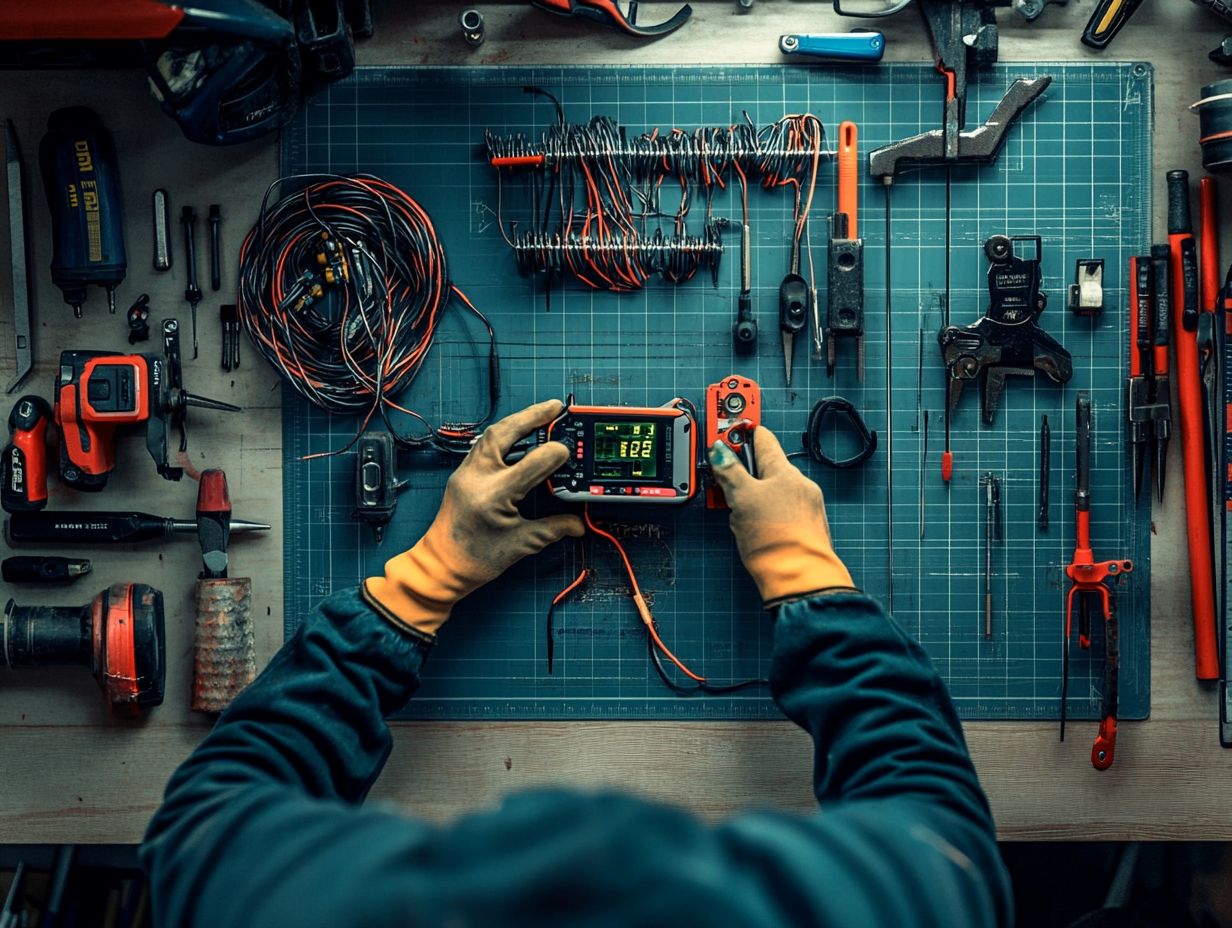
Inspecting the electric bicycle wires is an essential part of e-bike maintenance that guarantees the reliability and safety of your vehicle s electrical systems, ensuring that all batteries are functioning effectively. This detailed guide takes you through a comprehensive approach, beginning with a meticulous visual inspection to spot any visible damage or wear on the wires.
Next, testing the electrical system, such as using a multimeter, enables you to verify continuity and ensure the proper functionality of the wiring. By systematically addressing each component in this inspection process, you can avert potential failures and significantly enhance the overall performance of your e-bike. For more detailed guidance, consider preventing electric bicycle electrical failures.
Visual Inspection
Looking over your electric bicycle wires is the first crucial step in identifying potential issues that could compromise both the functionality and safety of your e-bike, including assessing the battery inspection needs. During this essential phase, examine the wiring closely for any signs of fraying, discoloration, or corrosion, which could lead to electrical failures. These indicators could point to underlying problems that might pose risks while you re out riding, impacting your overall riding experience.
Looking over your wires isn’t just a chore; it’s essential for safety. Make it a vital part of quality checks and integrate it into your regular maintenance routine. For a thorough approach, refer to our guide on how to perform a comprehensive electric bicycle check-up to ensure a safe and reliable riding experience.
Check insulation for cracks or abrasions. These can expose wires, increasing the risk of shorts and electrical failures. Checking connection points for tightness and signs of wear can effectively prevent electrical disruptions. For more information on ensuring your e-bike is safe to ride, see how to ensure your electric bicycle is road-ready. Loose or oxidized connectors can create inconsistent power delivery, which might hinder your e-bike’s performance.
Inspect cable placement. Poor routing may lead to wheel failure over time. Regularly focusing on these details not only extends the life of your e-bike but also significantly enhances the overall safety and efficiency of your rides.
Don t wait! Regular checks can prevent costly repairs and ensure smooth rides.
Testing for Continuity
Testing continuity in your e-bike wires is essential. It ensures your e-bike electrical systems are secure.
By taking this crucial step, you can prevent malfunctions, ensuring your bike operates smoothly and efficiently with optimal pedal assist.
Start by setting your multimeter to the continuity setting, shown by a diode symbol. Always disconnect the battery first for safety.
Next, attach one probe to each end of the wire you’re testing. Make sure the connections are tight to avoid any electrical disruptions. When the multimeter beeps, it signals a complete path for the current, indicating that the wires are functioning properly. This simple method helps you quickly find any electrical trouble spots!
Identifying problematic areas in your electrical system enhances the overall reliability and safety of your electric bicycle.
Checking for Loose Connections
Check for loose connections in your e-bike’s wiring. This vital step helps maintain the reliability of its electrical systems.
Loose connections can lead to inconsistent power delivery, potentially causing erratic behavior or even total failure of critical components, including the brake system, while you’re out riding. To avoid these issues, learn how to identify electric bicycle performance issues. By meticulously inspecting connectors and terminals, you ensure that all electrical connections are secure, enhancing your overall riding safety and performance.
A thorough inspection involves both visual checks and feeling checks of the chain lubrication to ensure all components are functioning properly. For detailed guidance, refer to how to inspect your electric bicycle before riding. A quick visual scan for signs of wear, corrosion, or frayed wires can help you spot potential issues before they escalate. Gently tugging on connectors can also reveal any that might be loose; a properly secured connection should resist movement.
Investing time in inspecting these connections isn’t merely a preventive measure; it’s essential for ensuring that your e-bike operates smoothly. For more detailed guidance, check out how to fix electric bicycle connectivity issues. Also, confirm that the locking mechanism on your bike is secure, allowing you to enjoy your journeys with complete confidence.
Common Issues Found During Inspections
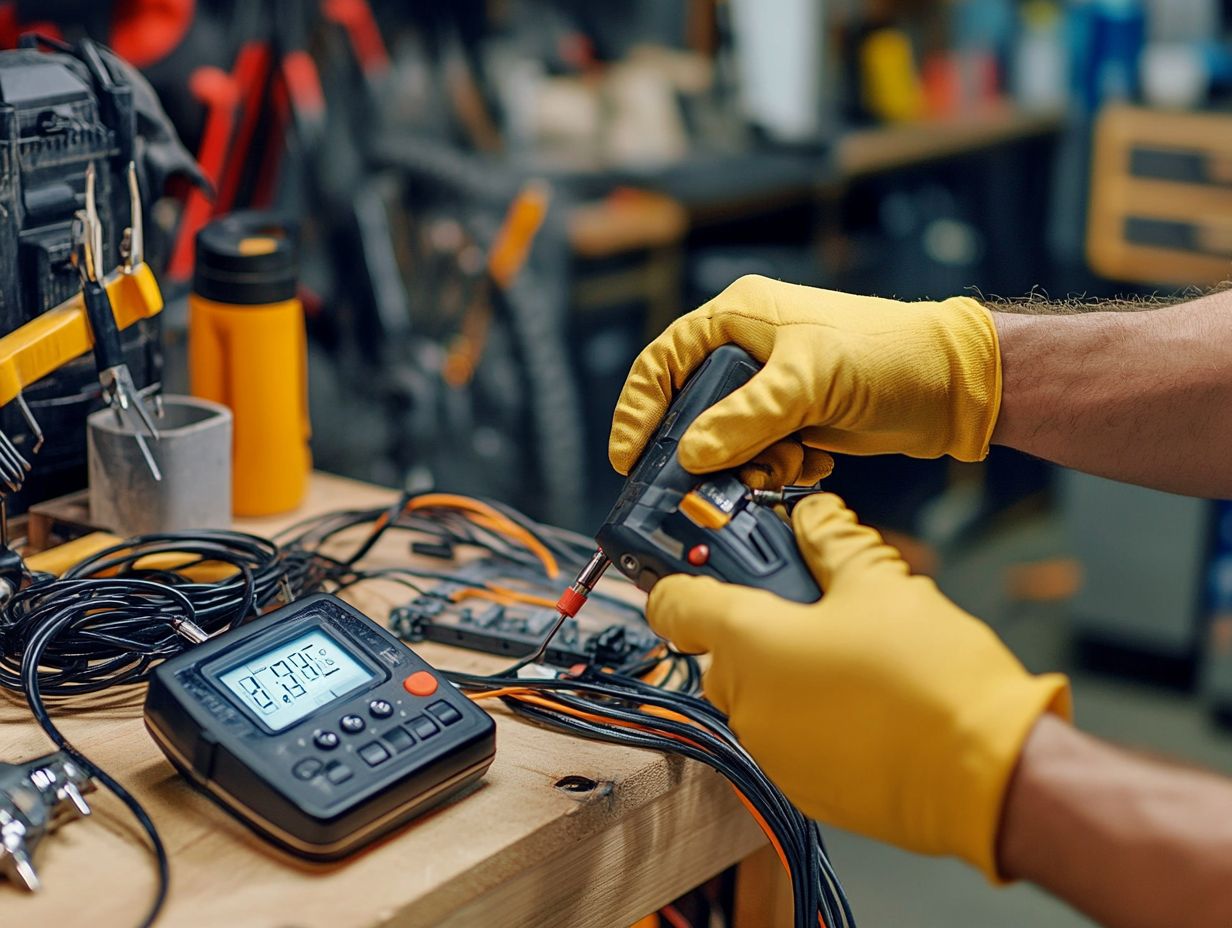
Identifying common issues during e-bike inspections is vital. It prevents bigger problems that can affect performance and safety. You might encounter issues such as worn brake pads, insufficient tire tread, and loose spokes, all of which can impact the structural integrity of your e-bike. This highlights the importance of a maintenance routine.
By addressing these concerns promptly through regular maintenance and servicing, you can significantly enhance the safety and reliability of your bike, ensuring a smoother and more enjoyable riding experience.
Identifying and Addressing Common Problems
Identifying and addressing common issues during e-bike inspections can significantly enhance your safety and performance. Problems like irregular tire pressure, misaligned handlebars, and worn-out brake pads are easily detected during regular checks.
For instance, when tire pressure is low, you may experience decreased handling and an increased risk of a flat tire. It s essential to regularly check and inflate your tires to the manufacturer s recommended levels. Misaligned handlebars can lead to discomfort and strain on your back and arms, so taking a moment to align them properly can make a world of difference in your comfort.
Worn brake pads can dramatically reduce your stopping power; inspecting them for wear ensures you can stop quickly and safely.
By addressing these common issues, you not only extend the lifespan of your e-bike components but also enhance your overall riding experience, allowing you to enjoy your journeys with greater peace of mind.
Tips for Maintaining Electric Bicycle Wires
Keeping your electric bicycle in top shape is key to thrilling rides and peace of mind! Maintaining the wires is crucial for ensuring both long-term performance and safety. Neglecting this essential aspect can lead to significant problems with the electrical system that may arise later.
To guarantee the reliability of your electric systems, it’s important to take preventive steps, including regular visual inspections and proper lubrication of connections (applying grease or oil to keep parts moving smoothly). For more detailed guidance, check out our guide to electric bicycle lighting repairs. These practices not only elevate the quality of your inspections but also enhance your overall riding experience, making it smoother and safer.
Preventive Measures for Long-Term Performance
Taking preventive steps is essential for ensuring the long-term performance of your electric bicycle wires, directly influencing both maintenance and riding safety. By regularly inspecting connections and using appropriate lubrication techniques, you can significantly reduce wear and tear, enhancing the overall reliability of your e-bike.
Creating a regular maintenance routine that incorporates these safety steps allows you to enjoy a safer and more efficient riding experience.
It’s vital to shield your electric bicycle wires from extreme weather and physical damage. Use cable covers or protective sheathing to prevent moisture and debris exposure, further extending their lifespan. Keeping wires tidy and free from tangles not only reduces strain during rides but also minimizes the risk of disconnections. For more detailed guidance, check out our article on how to troubleshoot electric bicycle electrical issues. Investing in high-quality hardware and components ensures that your e-bike remains resilient over time.
These simple steps ensure a smoother ride and save you from expensive repairs down the line!
Frequently Asked Questions
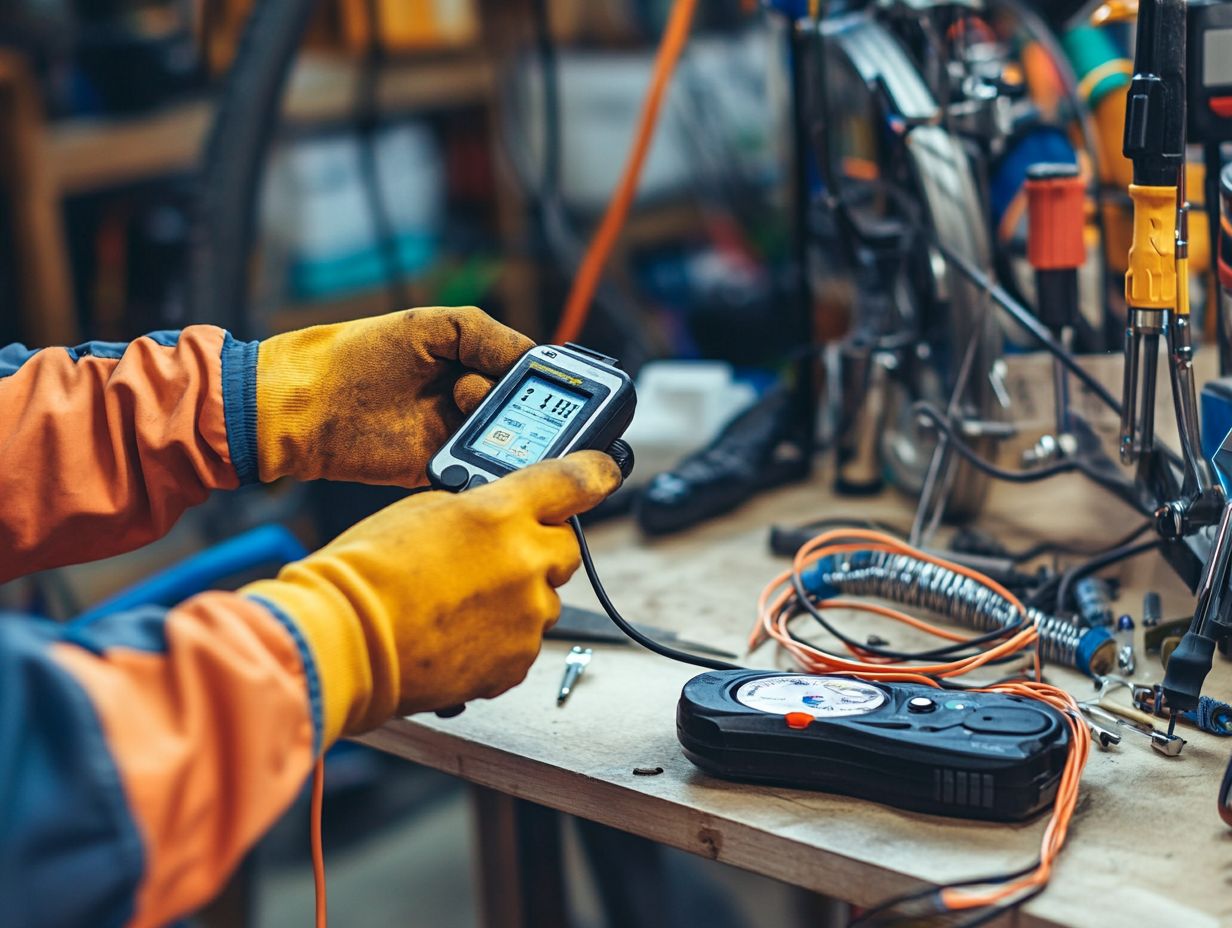
What is an electric bicycle wire inspection?
An electric bicycle wire inspection is the process of examining the wires and connections on an electric bicycle to ensure they are properly connected and functioning correctly.
Why is it important to perform electric bicycle wire inspections?
Performing regular electric bicycle wire inspections is important because it helps ensure the safety and proper functioning of your electric bike. It can also prevent potential malfunctions or accidents caused by faulty wires.
When should I perform an electric bicycle wire inspection?
You should perform an electric bicycle wire inspection at least once a month or before each ride. If you notice any issues with your electric bike’s performance or wiring, you should also perform an inspection immediately.
What tools do I need to perform an electric bicycle wire inspection?
To perform an electric bicycle wire inspection, you will need a set of basic tools such as screwdrivers, pliers, and wire cutters, as well as a voltmeter to test the electrical connections.
How do I perform an electric bicycle wire inspection?
Start by disconnecting the battery and removing the panels covering the wires on your electric bike. Use your tools to check the connections, making sure they are tight and secure. Use a voltmeter to test the electrical connections and look for any signs of damage or wear on the wires. Replace or repair any wires as needed.
Can I perform an electric bicycle wire inspection myself or do I need a professional?
With the right tools and instructions, you can perform an electric bicycle wire inspection yourself. However, if you are unsure or uncomfortable with performing the inspection, it is always best to consult a professional for assistance.
Ready to hit the road? Inspect your electric bike now and ride with confidence!




